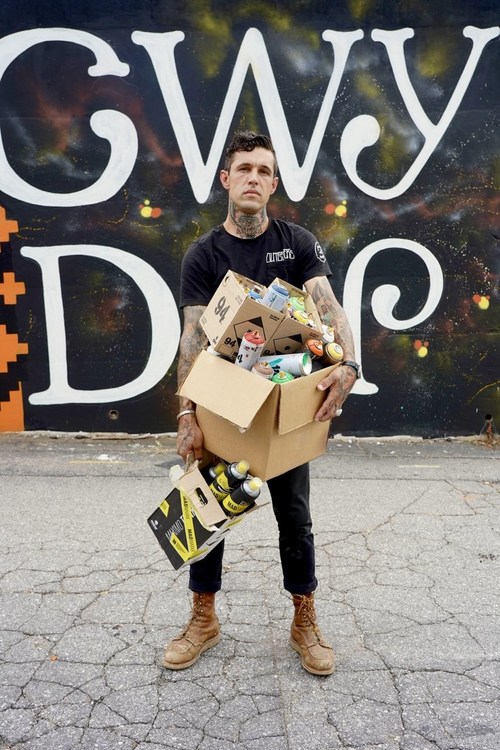The Intertribal Graffiti Jam: A first-of-its-kind event in the United States
ASHEVILLE, N.C., Nov. 2, 2022 /PRNewswire/ — At the intersection of Urban Native identity and street art you’ll find the Indigenous Walls Project. Through a series of public works of art on 25,000 square feet of donated walls across downtown Asheville, this project’s mission is to amplify native and indigenous voices from all indigenous nations across America and continue to support and grow the Land Back movement. As part of the project’s unveiling, the very first Intertribal Graffiti & Mural Jam was held in Asheville on October 20–23, 2022.
The event included live mural paintings of native culture throughout the city, graffiti installations, film and panel presentations, and an indigenous market from intertribal makers featuring handmade baskets, beaded works, jewelry, paintings, and native food. The weekend kicked off with remarks by Mary “Missy” Crowe, a member of the Eastern Band of Cherokee Indians, prior to the film screening and artists panel at the Wortham Center for the Performing Arts in downtown Asheville, which centered on indigenous environmentalism and restoration of the name ᎫᏬᎯ (Kuwohi) to the mountain currently known as Clingmans Dome
Raising Awareness For All Tribes Through Public Art
The Indigenous Walls Project is on a mission to expand people’s minds about the ancestral land where they’re currently standing. Jared Wheatley, a Cherokee Nation citizen, activist, and Asheville business owner started this project as a way to get people to focus on the land with the ultimate goal of bringing back land to every tribal nation.
Supported by East West Capital as the lead sponsor, BlueRidge Biofuel, Wheatley Construction, Epatage Workwear, Explore Asheville, Mosaic Realty, Dewey Property and Associates, Tarheel Paving, Sherwin Williams, LoopColors USA, Billy Made for Friends, The Hop Ice Cream, Horse and Hero, Red Fiddle Vittles, and Buxton Hall BBQ, the street art installations created during the event feature works from 12 artists across 10 tribes, and there are many more walls for other tribes to participate. Wheatley said, “If they want a voice, I’ll give them an opportunity to put it out there and amplify it in a public domain where we can encourage people to have the conversation. That’s what I’m here for. That’s my message.”
Participating artists from Cherokee, Diné (Navajo), Yaqui, Purépecha, Lakota, Apache, Quechan, Arawak, Menomimee, and Ojibwe nations included:
|
Name |
Nation |
City From |
|
Diné (Navajo) |
Phoenix, AZ |
|
|
Yaqui |
Phoenix, AZ |
|
|
Apache |
Albuquerque, NM |
|
|
Purépecha |
Portland, OR |
|
|
Diné (Navajo) |
El Paso, TX |
|
|
Quechan |
Trenton, NJ |
|
|
Arawak |
New York City, NY |
|
|
Menomimee |
St. Paul, MN |
|
|
Ojibwe |
St. Paul, MN |
|
|
Tohono O’odham |
Phoenix, AZ |
|
|
Zuni |
Los Angeles, CA |
Additional Exhibit Honors Cherokee Culture in Asheville
The Center for Craft in downtown Asheville has unveiled a new public art installation and accompanying parklet called ᏔᎷᏣ The Basket. This exhibit honors the ancient craft of Cherokee basket making traditionally made with rivercane. It also marks the location of a former trading route on the Cherokee’s ancestral land.
Majority-Female Indigenous Owned Brewery Opens in Asheville
Asheville’s craft beer scene continues to diversify with new flavors from new creators. The latest brewery to town is 7 Clans Brewing which honors the long tradition of women within indigenous cultures crafting fermented beverages. The name is derived from the 7 Clans of the Cherokee. Flavors include a Brandy Barrel-Aged Blueberry Sour, the mega-hopped Uketena Double IPA , Strawberry Saison, and Sali Persimmon Sour.
The Land of the Anigiduwagi
Asheville is the home of the Anigiduwagi, the original name for the Cherokee Tribe prior to the Indian Removal Act and resulting Trail of Tears. The Eastern Band of Cherokee Indians (EBCI) are descendants of those who refused to be relocated. They either hid in remote areas of the mountains or returned from Oklahoma years later.
During the 1800s, tribal members purchased what is now known as the Qualla Boundary, a reservation located in Western North Carolina that is kept in trust by the federal government.
Learn the history of Cherokee land grabs in Western North Carolina with “As Long as the Grass Shall Grow.” Drew Reisinger, the Buncombe County Register of Deeds, in collaboration with the EBCI, made news with this unprecedented acknowledgement that the land on which Asheville sits “was acquired through violence, oppression, coercion and broken treaties.”
This interactive digital webpage features maps and source documents outlining a difficult, yet necessary, story about the true history of Buncombe County.
For more the latest updates and information on the Indigenous Walls Project, visit www.indigenouswallsproject.com. For more information on the diverse people, culture and art being honored and celebrated in Asheville, visit ExploreAsheville.com.
SOURCE Explore Asheville Convention & Visitors Bureau

